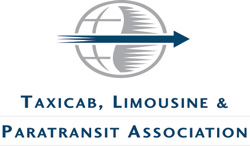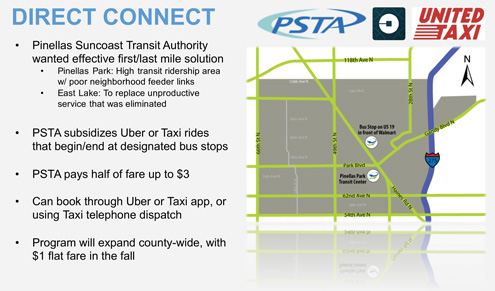 |
TLPA Participates in a Transportation Research Board International Conference on Demand Responsive Transportation |

by Harold Morgan
Executive Vice President
The Taxicab Limousine & Paratransit Association (TLPA) participated in the Transportation Research Board International Conference on Demand Responsive Transportation: Paratransit from Dial-a-Ride to Technology Enabled Services. It was held in Breckenridge, Colorado, September 25-28, 2016.
TLPA Executive Vice President Hal Morgan attended the conference and made a presentation at the meeting. The Taxicab, Limousine & Paratransit Foundation was a sponsor of the conference. TLPF President Robert McBride of Metro Transportation, Denver, CO, attended the conference as did TLPA members: Jeff Maltz, SilverRide, San Francisco, CA; Sid del Cardayre, Van Go of Richmond, Richmond, VA; Judy Swystun, Black & White Cabs, Norfolk, VA; Matthew Mohebbi, IT Curves, Gaithersburg, MD; and Izzy Aala, CabConnect, Dayton, OH.
The conference was attended by approximately 150 people representing state and local DOTs; the Federal Transit Administration (FTA); the U.S. General Accounting Office; consultants; technology companies; Uber; Lyft; and the private sector.
There were twenty-six international attendees from Europe, Canada and Australia. The conference featured sixty-eight individual presentations and there was a poster session for nine papers not selected for presentation. Hal Morgan spoke at a plenary session on the topic "How the Taxicab Industry Is Adapting to Competition from Transportation Network Companies."
There were a number of key themes that one could identify from the conference. These include:
However, the overarching focus of the conference was "how can the use of TNCs reduce the cost of ADA paratransit?" Following are the pros and cons of two examples that were presented.
Use TNCs as non-dedicated service providers for ADA paratransit service
For example, transit agencies could use TNCs as non-dedicated service providers for ADA paratransit service to potentially reduce an agency's cost per trip. The benefit for trip schedulers would be that the overall unit cost to transit agencies can be reduced by assigning to TNCs unproductive trips (peak-overflow trips, trips in low-demand areas and at low-demand times, long, out-of-the-way trips).
The benefit for dispatchers would be that overall unit costs can be reduced by using TNCs to respond to late running vehicles, break downs and re-emerging no shows. Finally, if TNCs had accessible vehicles, they would provide more options for schedulers and dispatchers. However, there are issues and obstacles to using TNCs as non-dedicated service providers for ADA paratransit service.
ADA paratransit trip requests are typically booked and scheduled in advance, while most apps provide immediate response only. However, in some cities, TNCs have introduced concierge services which can intake trip requests in advance - from paratransit schedulers or dispatchers and dispatch them live to TNC drivers. Some TNC apps now allow advance scheduling, activating the request to ensure timely pick-ups.
ADA Paratransit agencies/contractors or taxi companies coordinate service delivery and know real time location of their vehicles. TNCs are totally decentralized except for those few cities with concierge services.
Transit agencies require stringent eligibility criteria, background checks, and driver participation in drug and alcohol checking. Transit agencies also require consistency in driver training. TNCs' eligibility criteria and background checks are not as stringent.
TNCs required training for drivers of accessible vehicles is probably not as comprehensive as public transit agencies and private paratransit operators. A solution could be to allow voluntary TNC driver participation where the drivers would agree to meet higher standards as is the case with taxicab drivers in some cities.
Transit agencies require specific levels of vehicle insurance and transit agencies require indemnification. Neither TNCs nor their drivers appear to have insurance programs that meet typical transit agency insurance requirements.
According to speakers to the conference, to date, there are no examples of a transit agency using a TNC to provide an actual ADA paratransit trip.
Use TNCs as a "non-ADA" alternative for ADA customers
Also, transit agencies could use TNCs as a "non-ADA" alternative for ADA customers to reduce the ADA paratransit demand and hence to potentially reduce an agency¹s total cost to provide paratransit services.
For example, the cost of an ADA trip may be $45. If an ADA eligible client volunteered to take a taxicab or TNC service in lieu of scheduling ADA paratransit for his or her trip, the agency's cost for that trip would be capped at $15. Therefore, the total savings from each taxicab/TNC trip diverted from the ADA paratransit service is $30.
The problem for an agency is that it only takes two new trips via taxicab or TNC vehicle to use up the $30 saving. A number of transit agencies have had to limit the use of "non-ADA" alternative trips because of budgetary issues. Other obstacles to using TNCs as a "non-ADA" alternative for ADA customers to reduce the ADA paratransit demand include:
First Mile/Last Mile
Another topic that was well discussed during the conference was the concept of meeting "first mile/last mile" demand. "First mile/Last mile" refers to the means by which transit customers gain access to the transit service from the origin of their trip, and the means of travel from the point where they exit the transit service to reach their final destination.
The modes of travel for the "first mile" or "last mile" of a transit trip vary. Walking is most common, but other means exist including biking, automobiles (park and ride), etc.
The "first mile/last mile" challenge can represent a significant problem, in particular, outside of dense urban environments where walking is a viable option and wait times are acceptable. It is a well established that the ease of access from origin and/or to the final destination significantly affects the attractiveness of transit as a mode of choice.
There has been much discussion about the ability of transportation network companies "to solve the first mile/last mile problem", as if there were one single problem to be solved. Participants at the conference noted that there is no single unified concept of first mile/last mile, but rather a variety of land use and transportation contexts created by a variety of characteristics: residential density, employment density, auto ownership, pedestrian facilities and accessibility, road networks, etc., which in turn are subject to different travel behavior and patterns.
The problems in outer low density suburbs are unlikely to be amenable to the same solutions as are those of underserved but dense inner suburbs. In addition, the different shared use modes have different characteristics as well.
First mile/last mile may be an attractive shorthand for describing complex situations, but it does a disservice to designing appropriate services. Pinellas County, Florida is currently utilizing both a local taxicab company (United Taxi of Clearwater) and Uber in a Pilot Project
that allows clients within certain areas of Pinellas County to summon either company for a subsidized ride in restricted areas with reduced or eliminated bus service.

There were presenters that extolled the use of taxicabs in their demand responsive projects. In fact, a number of the European presenters discussed their reliance on taxicabs in their mix of demand response transportation options. These presenters noted that discussions of incorporating TNCs as a demand responsive transportation option was minimal in many countries in Europe.